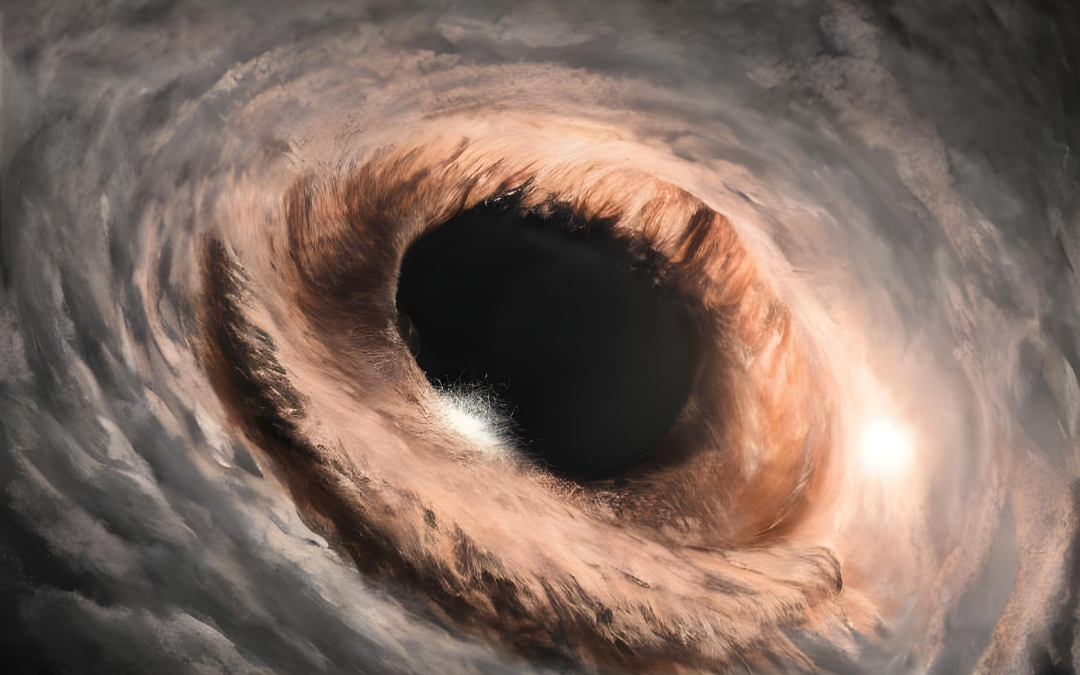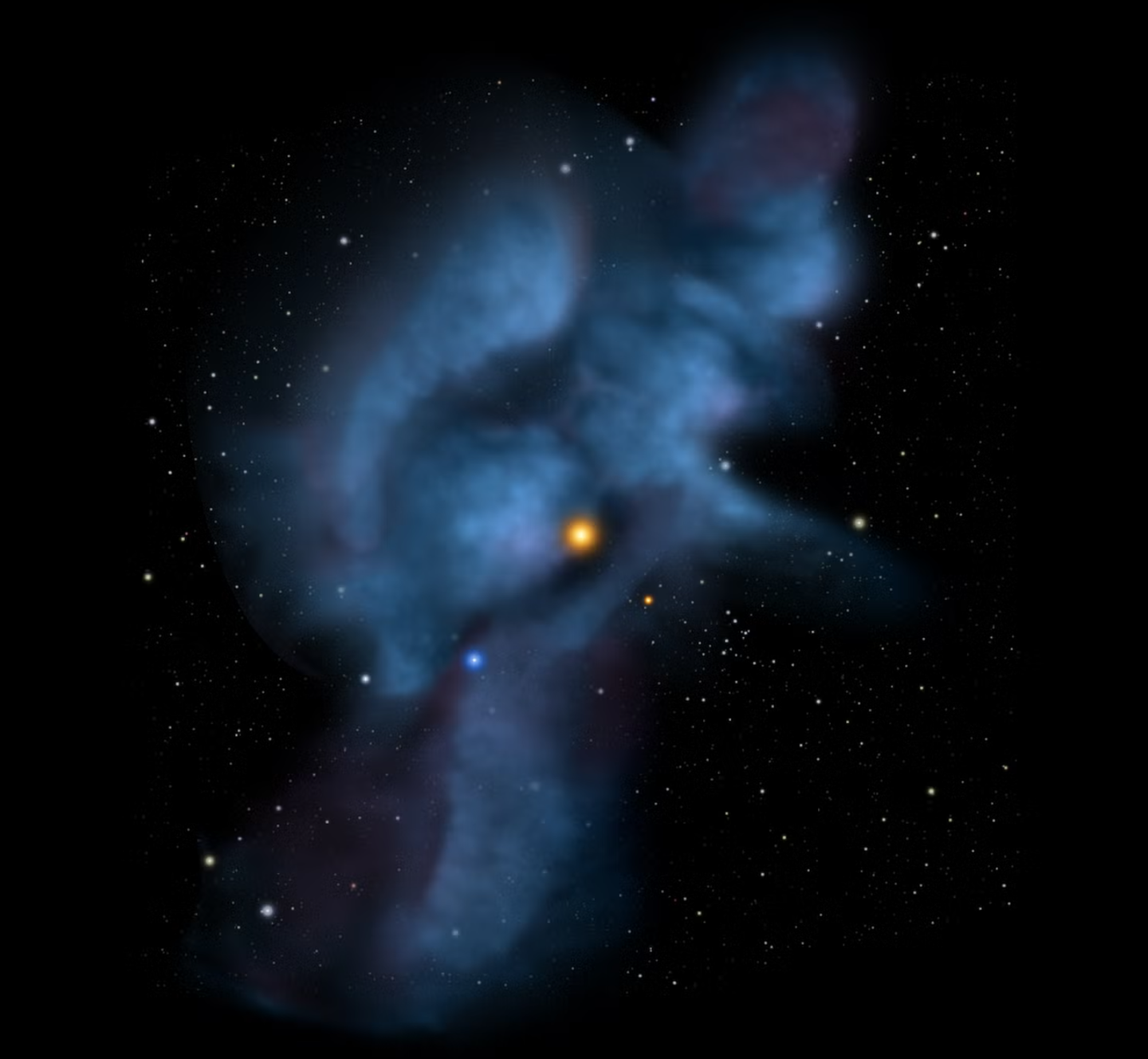Astrophysicists discover a fascinating connection between black holes and dark matter
Imagine you’re exploring the vastness of space, contemplating the mysteries of supermassive black holes (SMBHs) and dark matter.

Scientists have proposed that pairs of SMBHs can merge into a single, larger black hole due to previously overlooked behavior of dark matter particles. (CREDIT: Creative Commons)
Imagine you’re exploring the vastness of space, contemplating the mysteries of supermassive black holes (SMBHs) and dark matter. Now, visualize how these seemingly distinct cosmic entities might be interlinked. Recent research has unveiled a fascinating connection between the largest and smallest objects in the cosmos: SMBHs and dark matter particles.
In a groundbreaking study, scientists have proposed that pairs of SMBHs can merge into a single, larger black hole due to previously overlooked behavior of dark matter particles. This discovery offers a solution to the long-standing “final parsec problem” in astronomy.
This research, detailed in the paper titled "Self-interacting dark matter solves the final parsec problem of supermassive black hole mergers," was published in the journal Physical Review Letters.
In 2023, astrophysicists detected a pervasive “hum” of gravitational waves throughout the universe. They suggested this background signal originated from millions of merging SMBHs, each billions of times more massive than our Sun. However, theoretical simulations revealed a challenge: as these massive celestial bodies spiral closer together, their approach stalls when they are about a parsec apart—approximately three light years—preventing a merger.
This “final parsec problem” not only contradicted the idea that merging SMBHs were the source of the gravitational wave background, but it also clashed with the theory that SMBHs grow from the merger of smaller black holes.
Gonzalo Alonso-Álvarez, a postdoctoral fellow in the Department of Physics at the University of Toronto and the Department of Physics and Trottier Space Institute at McGill University, states, “We show that including the previously overlooked effect of dark matter can help supermassive black holes overcome this final parsec of separation and coalesce. Our calculations explain how that can occur, in contrast to what was previously thought.”
Alonso-Álvarez's co-authors include Professor James Cline from McGill University and the CERN Theoretical Physics Department in Switzerland, and Caitlyn Dewar, a master’s student in physics at McGill.
SMBHs are believed to reside at the centers of most galaxies. When two galaxies collide, their SMBHs fall into orbit around each other. As they orbit, the gravitational pull of nearby stars slows them down, causing the SMBHs to spiral inward toward a merger.
Previous models suggested that when SMBHs get within roughly a parsec of each other, they begin to interact with the dark matter cloud, or halo, surrounding them. The gravity of the spiraling SMBHs was thought to expel dark matter particles from the system, leading to a sparsity of dark matter and a stall in the SMBHs' inward spiral.
However, the new model from Alonso-Álvarez and his team reveals a different scenario. They found that dark matter particles interact with each other in such a way that they are not dispersed. The density of the dark matter halo remains high enough that interactions between the particles and the SMBHs continue to erode the SMBHs' orbits, paving the way for a merger.
“The possibility that dark matter particles interact with each other is an assumption that we made, an extra ingredient that not all dark matter models contain,” explains Alonso-Álvarez. “Our argument is that only models with that ingredient can solve the final parsec problem.”
The gravitational waves from these cosmic collisions form a background hum with much longer wavelengths than those first detected in 2015 by the Laser Interferometer Gravitational-Wave Observatory (LIGO). Those waves were generated by the merger of two black holes, each about 30 times the mass of the Sun.
In recent years, scientists using the Pulsar Timing Array have detected the background hum. This array measures minute variations in signals from pulsars—rapidly rotating neutron stars that emit strong radio pulses—to reveal gravitational waves.
"A prediction of our proposal is that the spectrum of gravitational waves observed by pulsar timing arrays should be softened at low frequencies," says Cline. "The current data already hint at this behavior, and new data may be able to confirm it in the next few years."
Beyond providing insight into SMBH mergers and the gravitational wave background, this new research also offers a window into the nature of dark matter.
“Our work is a new way to help us understand the particle nature of dark matter,” says Alonso-Álvarez. “We found that the evolution of black hole orbits is very sensitive to the microphysics of dark matter, and that means we can use observations of supermassive black hole mergers to better understand these particles.”
For instance, the researchers discovered that the interactions between dark matter particles they modeled also explain the shapes of galactic dark matter halos.
“We found that the final parsec problem can only be solved if dark matter particles interact at a rate that can alter the distribution of dark matter on galactic scales,” adds Alonso-Álvarez. “This was unexpected since the physical scales at which the processes occur are three or more orders of magnitude apart. That’s exciting.”
This research bridges the gap between two of the universe’s most mysterious phenomena, shedding light on how they might influence each other. By continuing to study these cosmic giants and their dark matter counterparts, you can gain a deeper understanding of the universe's intricate workings.
Note: Materials provided above by the The Brighter Side of News. Content may be edited for style and length.
Like these kind of feel good stories? Get the Brighter Side of News' newsletter.



